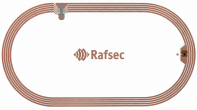April 7, 2003 – Rafsec, a subsidiary of Finland’s UPM-Kymmene Corp., has developed a line of transponders that can be embedded in plastic containers or pallets during the injection-molding process. The transponders can be adapted for different applications and environments and are designed to function for the lifetime of the crate or pallet.
There are several benefits to putting transponders inside containers, rather than affixing them with smart labels. One is they won’t fall off when the crates, totes or pallets are washed at high temperatures or with harsh chemicals. Another is they are much less likely to be damaged as the containers are bounced around inside a truck or railcar. But creating a tag that could be embedded in plastic took some research and development.
“There are two basic challenges,” says Rafsec president Timo Lindström. “One is the physical stress caused by the high temperature and pressure used in the injection molding process. The other is ensuring good adhesion between the transponder and the plastic used to make the container. We have laminated the basic transponder with additional layers of different plastics to solve both problems.”
The Rafsec In-Mould Transponder line currently uses 13.56 MHz chips based on the ISO 15693 standard. The chips are available from Philips Semiconductors, Infineon Technologies, and < popuplink http://www.st.com ST Microelectronics>. Rafsec will also offer embedded transponders with ISO 18000-3 chips from Philips and plans to also support ISO 18000-6A and ISO 18000-6B, EPC Class 0 and EPC Class 1.
EM Marin currently offers UHF chips based on ISO 18000-6A and Philips produces chips based on ISO 18000-6B. Matrics offers EPC Class 0 tags and Alien Technology current sells EPC Class 1 chips.
The transponders can be read/write (depending on the chip used), which allows information about the contents of the crate or pallet to be written to the transponder. Lindström says the transponders can cost less than $1, depending on the volume, form factor, chip and other factors. Since the containers might go through seven or more turns a year and last five year or more, the price per use will likely be no more than a few pennies.
Rafsec will design a transponder to fit within the mold of plastic containers, pallets or products with plastic housing. Antenna sizes can range from 25 mm to 150 mm (about 1 inch to 6 inches), depending on the read range needed and the environment the containers will be used in.
Rafsec In-Mould Transponders have been tested in a plastic meat crate solution with Bekuplast, a German injection-molding company. The embedding of the transponder should not effect its performance. “It depends on what materials are carried inside,” Lindström says. “But that is the case whether you are using a label transponder or an embedded transponder.”


